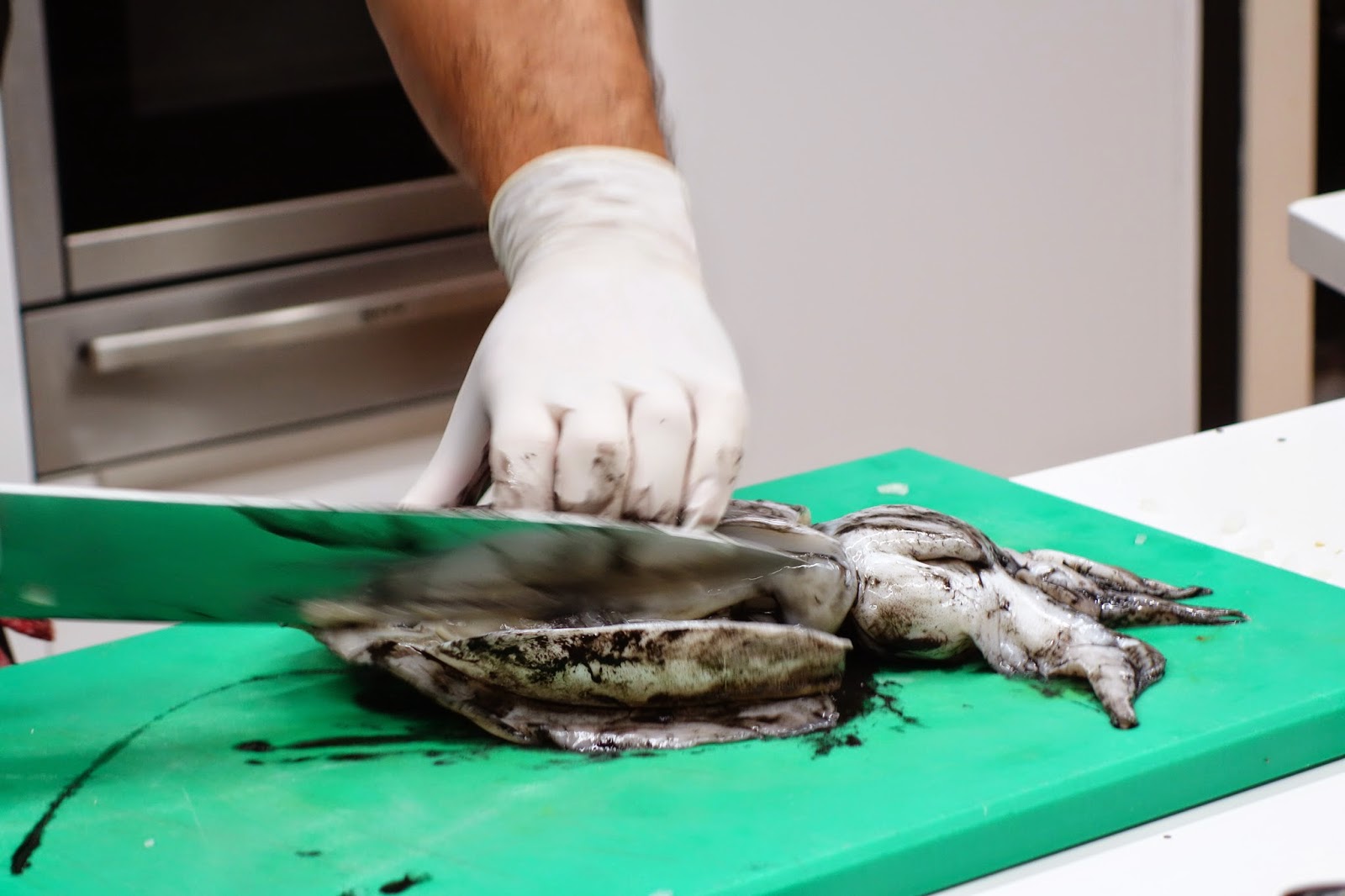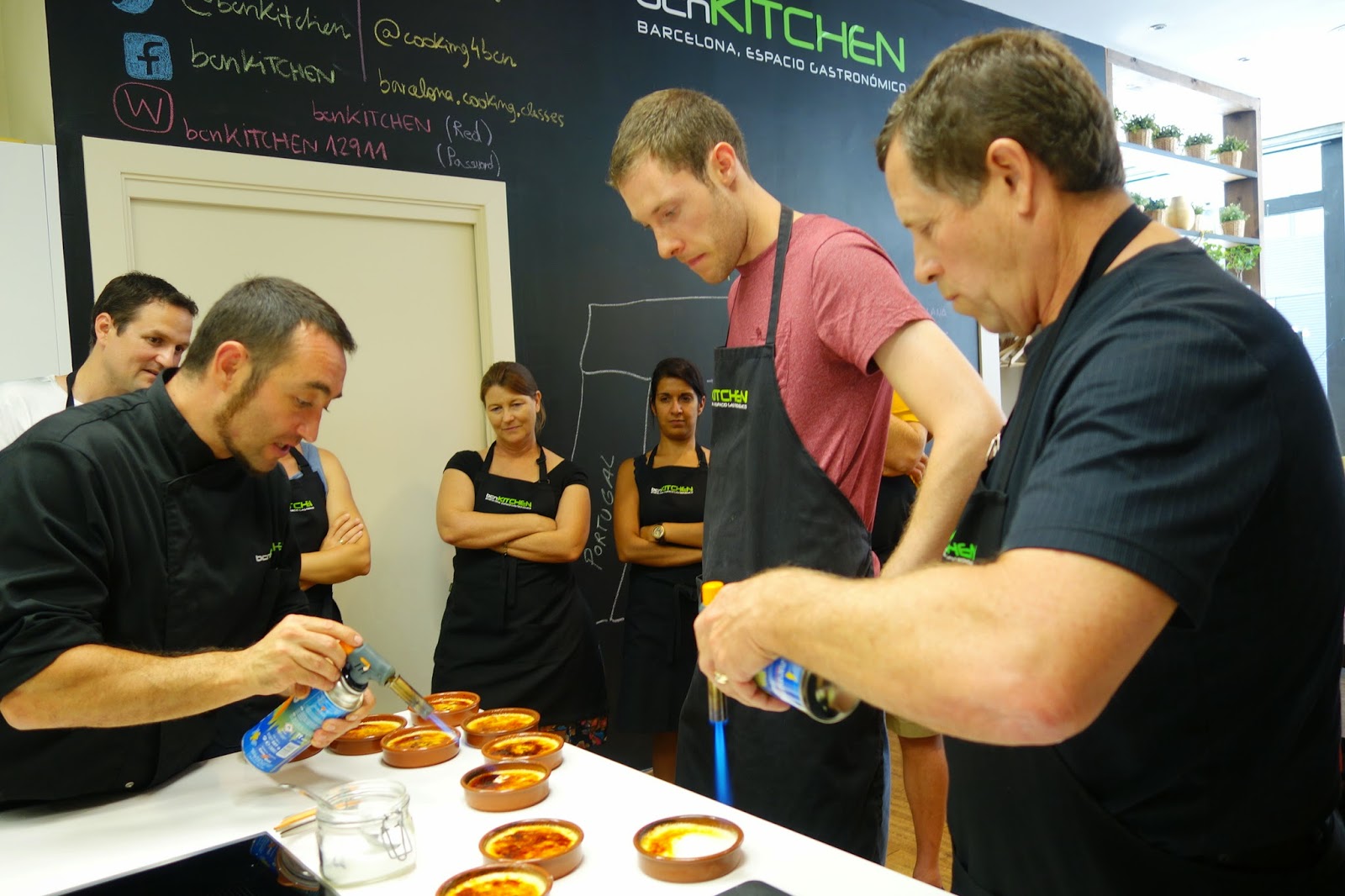 We are in Barcelona for a class in Traditional Spanish
Dishes. The menu has contributions from all over the country ~ Catalan
Tomato Bread (recipe previously posted), also called Pa & Tomaquet, from ~ you guessed it ~ from Catalunya.
Gazpacho from Andalucia in southern Spain; Spanish Omelet, or Tortilla de Patata from central Spain; and the famous
Paella from the Valencia coast. And my personal favorite, Catalan Creme, which is
basically Creme Brulee. We even get a little geography lesson.
We are in Barcelona for a class in Traditional Spanish
Dishes. The menu has contributions from all over the country ~ Catalan
Tomato Bread (recipe previously posted), also called Pa & Tomaquet, from ~ you guessed it ~ from Catalunya.
Gazpacho from Andalucia in southern Spain; Spanish Omelet, or Tortilla de Patata from central Spain; and the famous
Paella from the Valencia coast. And my personal favorite, Catalan Creme, which is
basically Creme Brulee. We even get a little geography lesson.It is our custom to take a cooking class when we travel, and we have learned to love it for several reasons.
First of all, there is much to be learned about how a culture is defined by it's foods. We learn what they eat and why. We learn what has influenced their traditional dishes ~ the climate, the living conditions, etc. We usually get a chance to go to the local markets for supplies, and we have a guide for these events that can answer our questions. And we also enjoy the opportunity to rub shoulders with people from all over the world who are in class with us that day.
The most fun, however, is when we take the recipes and the experience home to friends and family. We host a big international dinner, preparing these same dishes, and simultaneously toss some of our favorite memories of the trip up on the big screen. All the guests are required to participate in some way (i.e. for Thailand, everyone helped fill the egg rolls and grind the spices for fresh curry; for Italy everyone had a hand in rolling the fresh "picci" noodles, etc.) If you don't want to get your hands messy, you don't get to eat!
We get a brief introduction at the cooking site. The facility looks really nice; you can see here that we will each have our own prep station, and there are 2 cook stations that we will work from jointly.
Then we are off to market (on foot).
There are 10 of us in class today, plus the instructor. One other couple is also from the US; one couple is from Australia; another from Germany; and there are a set of friends from London.
We get a little information before entering the market, including a warning not to get in the way. Evidently (and this is the first time ever for us, out of dozens of markets all over the globe), tourists are tolerated but not-super-welcome here.
And sure enough, these are some of the banners that we see on the edge of the town square, with the market at it's center.

 I'm intrigued, because, as I said, we've not experienced this anywhere else on the map.
I'm intrigued, because, as I said, we've not experienced this anywhere else on the map. I can't help but wonder what has prompted this anti-intrusion attitude and campaign.
It seems the building was previously an old convent of some type ~ in fact, you can see here on the right, that the original outside (white) wall was preserved and retained. When the decision was made to renovate the building into a bustling marketplace, it was welcomed by some, and resented by others as permanently changing the face of their neighborhood.
I snapped this picture of the aerial view, after the market renovation (the curvy roofed building in the middle) was completed , which gives me some insight. I'm not sure that I would be able to swallow a pill this big, either. It certainly explains both the attitude and the signage.
But I digress. Back to cooking class........
As with most local markets, there is a lovely array of fresh-grown fruits & veggies available for purchase. Farm-to-table is something I've learned a greater appreciation for through our travels. It's the way most other countries still function, and is refreshingly dissimilar to our standard grow-to-ship food culture in the US.
These are the famous "hanging tomatoes" that we need for the Catalan Tomato Bread. They are by far the most expensive of a dozen or more types of tomatoes grown and used here, but are, according to our chef / guide, by far the most flavorful.
We saw little tomato tee-pees in the country gardens on some of our train trips ~ which is how they "hang" them to grow. Couldn't really snap a photo when the train was going 300 kph (something like 180mph), though, so you'll have to take my word for it. Or just "Google" it!
Just remember, the tomato bread is only going to be as delicious as your tomatoes are. This is something you would not want to make during the winter ~ hothouse tomatoes are not going to cut it.
We make our purchases and make our way back to the cooking school. I definitely felt rebuffed at market more than once for being present, for being in the way, for being a "tourist". Even though we are supporting the local economy and the local growers.......yeah, it's not me who built the blasted market right in the middle of their neighborhood. One of our group was even scolded soundly for taking a picture when it was clearly posted (in Spanish) "No pictures allowed". (Personally, I think it just gives her a reason to yell at tourists.)
So here we are, all ready to go! Chef Alvaro starts the class by stepping through the directions for each dish, and then assigning each work station their task.
Because the prawns, mussels, and cuttlefish (a type of squid) are fresh, we get the added demonstration of how to clean and prep the seafood.
Cuttlefish, or Sepia, has black ink just like squid do. Hence the gloves, otherwise your hands get dyed black. Sometimes you'll see black paella made with the ink, but Chef has something else planned for today. I don't think I'll be repeating this part at home......It's really messy!
He also demonstrates some basic knife skills. He's very fast!
The fresh prawns are de-headed and peeled, and all of that fishy goodness gets added to the stock pot for the broth that we are making to use in our paella.
Meanwhile Mr. C & I are completing our assignment, which is to chop and saute the veggies ~ peppers, carrots, and onions.
It's starting to smell really good in here!
Next we add the calamari and cook it for just a bit.
We are having fun.
We are having fun.
The stock is coming along nicely, simmering away.
It smells wonderful.
It smells wonderful.
Meanwhile, the Catalan Creme Team is working, too. This version has a bit of citrus in it, the orange and lemon skins are taking a short swim in the milk with a cinnamon over a low heat.
And the Gazpacho Team is also having good results. The fresh veggies are prepped and chunked and are heading into the food processor. All that's left after that is a dash of vinegar and a little garnishment.

The Spanish omelet, which is really potatoes, not so much eggs, is served at any time of day in Spain; for breakfast or lunch or dinner or tapas; hot or cold. Very popular.
Here she is learning how to "turn" the omelet onto a plate before returning it to the pan to finish cooking the other side.
It's a little tricky. She's doing a good job.
It's a little tricky. She's doing a good job.
And back in Paella Land, in goes the tomato sauce.
And next it's time for Chef Alvaro's "secret ingredient". It's something he saved when he cleaned the Cuttlefish, and it looks like this: Can you guess what it is???
It's spleen.
It's Cuttlefish spleen.
And then, per Chef's instructions and against my better judgement,
I added it to my Paella.
The next step is to add the rice and saffron and some of that beautiful broth. I have really high hopes for all this........
Chef adds the last of the seafood, the prawns and the mussels, and then finishes it off in the oven.
The finished product is a work of art! I can't wait to eat this!
It's time for all the finishing touches.
We need to torch the Catalon Creme.
I'm excited to buy one of these gadgets when I get home.
And it's time to dish up the Gazpacho
So now we sit to enjoy the fruits of our labor. It's a really nice group of people, we've had a fun day together.
Catalan Tomato Bread
Gazpacho soup
Spanish omelet
And our beautiful, nearly inedible Paella. So sad. The entire batch tasted like spleen. So disappointing!
Thank goodness we get to conclude with Catalan Creme!
And so we conclude another
International cooking class experience ~
thanks Chef Alvaro and BCN Cooking School.
Look for all these recipes on the blog site!
International cooking class experience ~
thanks Chef Alvaro and BCN Cooking School.
Look for all these recipes on the blog site!
PS: Here's my recipe tips: The Spanish omelet is in need of some seasoning. Serious salt & pepper, at the very least.
And I recommend that you skip the Cuttlefish spleen in the Paella.



































No comments:
Post a Comment
Join the conversation ... comment now!